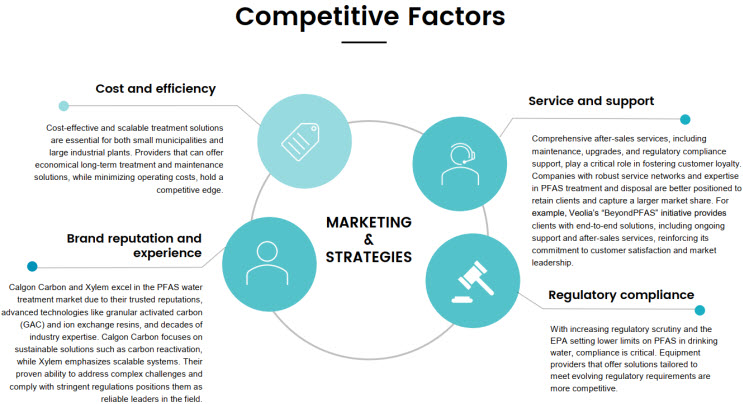Market Outlook: Growth Opportunities In PFAS Water And Wastewater Treatment (2024-2031)
By Shilpa Tiku

The U.S. PFAS water and wastewater treatment equipment market is expected to grow at over 11% from 2024 to 2031, primarily driven by stringent regulatory requirements and enhanced public awareness of PFAS contamination risks. The market was estimated at over $90 million in 2024.
Treatment technologies, including activated carbon adsorption, ion exchange, and membrane technologies, are gaining traction due to their efficacy in PFAS removal. Investment by both municipal utilities and industries is growing to build necessary progress toward compliance with regulations. Factors like public advocacy initiatives, along with federal funding programs are helping further the market adoption.
Advanced Solutions For Short-Chain PFAS
The market is showcasing significant opportunities for companies that can create advanced solutions to address short-chain PFAS contamination. As regulatory standards become stricter, there may likely be an increasing interest in technologies such as electrochemical oxidation and advanced electrochemical methods. Companies that focus on low-waste and sustainable solutions will likely be in a favorable position for success. By investing in innovative technologies, keeping up with regulatory expertise, and prioritizing sustainability, companies can take advantage of the growing market while staying ahead of regulatory changes. Collaborating with industry and research partners can also drive innovation and improve market access.
The PFAS water and wastewater treatment market is broadening its focus from municipalities to include industrial sectors like manufacturing, food processing, and textiles. Technologies such as granular activated carbon, ion-exchange resins, and membrane technologies are being increasingly adopted to manage PFAS in wastewater, especially in coatings, packaging, and processing equipment. With the introduction of stricter regulations, companies that offer tailored solutions to meet the unique needs of different industries are likely to see significant growth in the evolving PFAS treatment landscape.
Technology
The price sensitivity associated with PFAS treatment solutions has led to some resistance, with activated carbon being the most cost-effective option, followed by resin-based technologies. However, even though reverse osmosis is the most expensive method, it is experiencing the fastest growth in PFAS removal due to its dual advantages: it effectively removes contaminants and contributes to water reuse initiatives.
As municipalities and industries place greater emphasis on long-term water sustainability, the adoption of reverse osmosis (RO) systems will likely be on the rise. The understanding that these systems not only tackle PFAS but also contribute to broader water reuse objectives is fueling investments in these advanced solutions. In response to this increasing demand, membrane manufacturers are innovating and improving their technologies, which enhances the cost-effectiveness and efficiency of RO systems.
This trend positions RO as a rapidly growing segment in PFAS treatment, with ongoing advancements anticipated to reduce costs and broaden its market appeal.
Competitive Market
The market is highly competitive and consolidated with the top three companies holding over 65% of the total market by revenue in 2024. The key companies in the market include Xylem Inc., Calgon Carbon Corporation, Jacobs Solutions, Inc., Clean Harbors, Inc., Veolia, Aquagga, EPOC Enviro, and Pall Corporation, among others.
End Users
The demand for PFAS treatment equipment is mainly fueled by the municipal sector, which made up about 70% of the total end-user market revenue in 2024. The industrial sector was the second-largest segment, holding an estimated 20% of the market share. In the next three to five years, we can expect a structural shift in the market, with the share of drinking water gradually decreasing. The industrial sector is set for significant growth, driven by stricter regulations that require advanced pretreatment solutions for wastewater before it can be discharged into municipal systems. Granular activated carbon was the leading technology in 2024, capturing over half of the market by revenue.
The chart highlights the competitive factors within the market.
With granular activated carbon continuing to lead the way in PFAS removal, the market is poised for evolution as companies develop specialized solutions tailored to meet the distinct needs of different industries and municipalities.
 Shilpa Tiku is the Chief Research Officer at Verify Markets. Shilpa has experience in research and consulting for over 20 years. She focuses on monitoring and analyzing emerging trends, technologies, and market dynamics in several global markets. To reach her for comments, interviews, or market consulting, call +1 210.595.9687 or email her at shilpa.tiku@verifymarkets.com.
Shilpa Tiku is the Chief Research Officer at Verify Markets. Shilpa has experience in research and consulting for over 20 years. She focuses on monitoring and analyzing emerging trends, technologies, and market dynamics in several global markets. To reach her for comments, interviews, or market consulting, call +1 210.595.9687 or email her at shilpa.tiku@verifymarkets.com.

